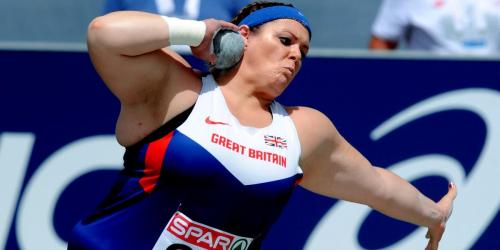 Amelia Strickler, photo courtesy of British Athletics
Amelia Strickler, photo courtesy of British Athletics
This is Paul’s column for last week. Paul Halford writes on British athletics for us on a weekly basis and provides us a view into athletes, many of us, on both sides of the proverbial pond, of whom we might not have much familiarity. Amelia Strickler is emerging as the top British women shot putter.
The shot put is among Britain’s weakest disciplines in global terms, but one woman who could be set to change that is US-born Amelia Strickler.
The 23-year-old, who grew up in the United States but has dual citizenship because her mother is British, this year gained her first GB representation and decided to move across the pond to further her athletics career.
With a PB of 17.13m, she is Britain’s No.2 this year, but the up-and-coming athlete has her sights set on the World Indoors. If she succeeds in making Birmingham she would become her country’s first female shot-putter to compete at a global senior championships since 2000.
Born in Ohio, she went to the state’s Miami University but has always felt an affinity for Britain. Indeed, she fulfilled a long-held ambition in recently being picked by England for next year’s Commonwealth Games.
“I think we grew up with a lot of British traditions anyway, so I feel like I know what’s going on over here. I still have a lot of family over here,” she says. The athlete from the Thames Valley Harriers club explains her reasons for moving to live in the UK: “Since I’m representing this country, I felt being over here would be better for me, getting to know people within British athletics and I think it would also give me a better chance of being selected for other opportunities.”
Already Strickler has represented Britain twice – this year at the European Team Championships in Villeneuve d’Asq and at the World University Games in Taipei, where she was sixth. She is hoping more success is to come, beginning with selection for the World Indoors despite the IAAF selection standard being set at 18.20m.
With that goal in view, she feels she is wintering well under the continued guidance of Miami University coach Steve Manz. It means exchanges of video footage and plenty of texting, but it’s a path worth taking, she believes.
“I’m sticking with Steve,” she says. “He’s a great coach. I love his lifting programme (that) he has me on. I love his ideas about the shot put. He makes it very simple for me because I’m the kind of athlete that can tend to overthink things… I think it’s going to work out.”
Strickler took up shot aged around 12-13, having been given chance to try a variety of events in school. “In the first week of practice, I had to do everything. I was like, ‘oh my gosh I can’t jump.’ But I picked up a shot put and I was better than everyone else. And when I was really young I didn’t lose a meet until I got to high school.”
She took a big leap forward when changing from the glide to rotational technique in her first year at college. However, she recalls the process was far from straightforward. “It was so difficult,” she says. “I came into college and I couldn’t throw far – I think it was 11m. Everyone wants immediate results, but I kept throwing 11m with the rotational as well all indoor season.
“Then fortunately by outdoors I made some big jumps and I went from 11m to 14.89m and qualified for the first round of nationals as a freshman, which was huge at the time. It paid dividends for me in that first year but it was a long eight months of ‘gosh, is it going to get any better?’ It definitely did so I’m glad I stuck with it.”
Looking at the bigger picture, the problem of adapting to new techniques is something she believes may be partially holding back British shot put. Not since Judy Oakes at the 2000 Olympics has a British woman competed on the global stage and the situation on the men’s side is only marginally better, with Carl Myerscough a rare Olympic representative in 2012.
“I think it’s a bit of everything,” she says of the reason for the paucity of British world-class throwers. “A lot of coaches over here I find are still stuck on the glides and the ones that aren’t stuck on the gliders don’t tend to know the rotational technique as well.”
Referring to US shot putters, who lead the way globally with the top three on 2017 rankings, she says: “The American rotational men at the moment are at a huge advantage over everyone. So I think rotational shot is going to be the way forward. We’re seeing a lot of up and coming women are rotational shot putters… I think the glide might even be extinct eventually just because it’s been stuck in ‘this is the way to do it’ [mentality].”



















